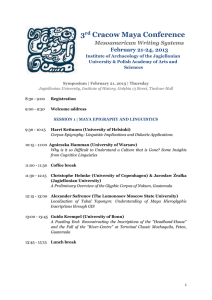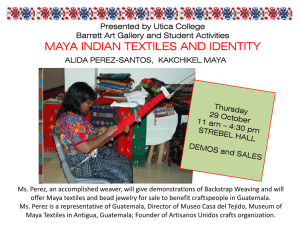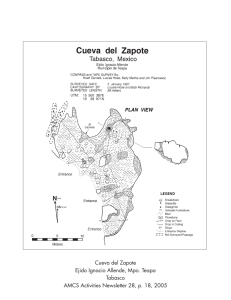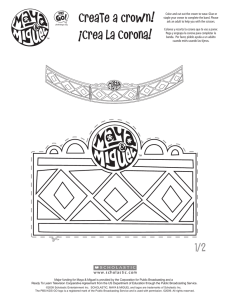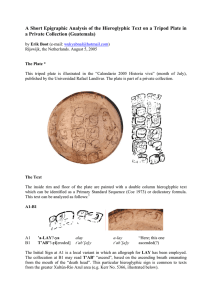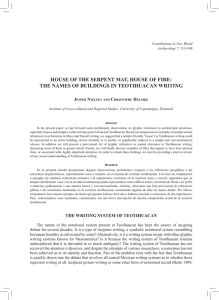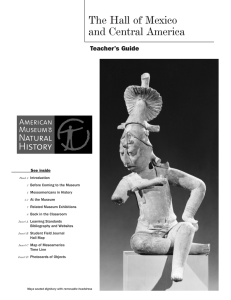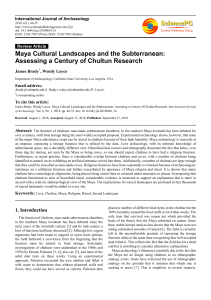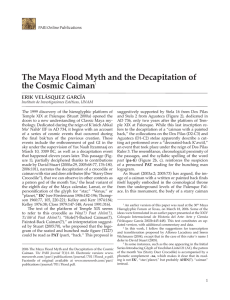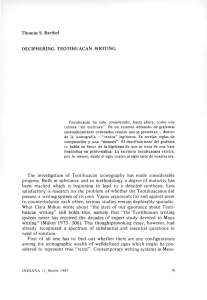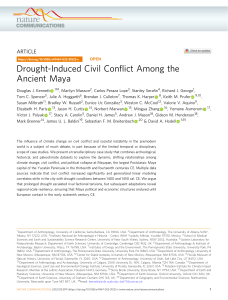Symposium | 21 Feb | Thursday Jagiellonian University, Institute of
Anuncio
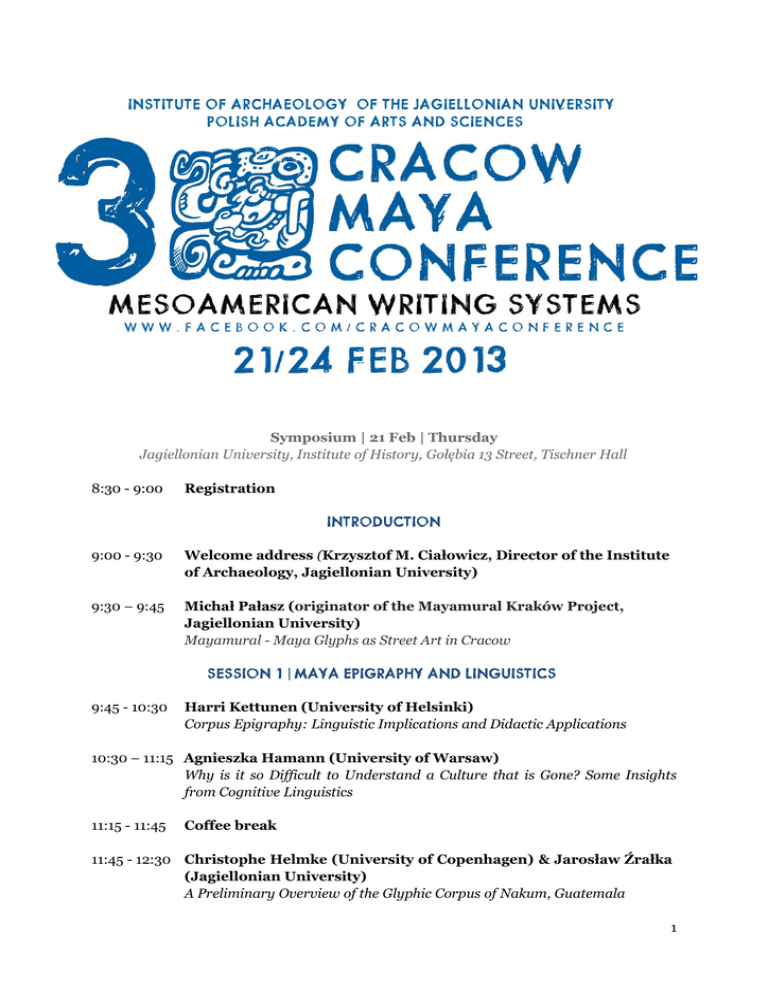
Symposium | 21 Feb | Thursday Jagiellonian University, Institute of History, Gołębia 13 Street, Tischner Hall 8:30 - 9:00 Registration INTRODUCTION 9:00 - 9:30 Welcome address (Krzysztof M. Ciałowicz, Director of the Institute of Archaeology, Jagiellonian University) 9:30 – 9:45 Michał Pałasz (originator of the Mayamural Kraków Project, Jagiellonian University) Mayamural - Maya Glyphs as Street Art in Cracow SESSION 1 | MAYA EPIGRAPHY AND LINGUISTICS 9:45 - 10:30 Harri Kettunen (University of Helsinki) Corpus Epigraphy: Linguistic Implications and Didactic Applications 10:30 – 11:15 Agnieszka Hamann (University of Warsaw) Why is it so Difficult to Understand a Culture that is Gone? Some Insights from Cognitive Linguistics 11:15 - 11:45 Coffee break 11:45 - 12:30 Christophe Helmke (University of Copenhagen) & Jarosław Źrałka (Jagiellonian University) A Preliminary Overview of the Glyphic Corpus of Nakum, Guatemala 1 12:30 - 13:15 Alexander Safronov (The Lomonosov Moscow State University) Localization of Tubal Toponym: Understanding of Maya Hieroglyphic Inscriptions through GIS 13:15 - 14:00 Guido Krempel (University of Bonn) Introducing a Stranger: The Tayra (Eira barbara) in Classic Maya Imagery and Writing 14:00 - 15:30 Lunch break SESSION 2 | WRITING TRADITIONS AND SYSTEMS OF COMMUNICATION IN CENTRAL MEXICO: FROM TEOTIHUACAN TO THE NAHUAS 15:30 - 16:15 Jesper Nielsen and Christophe Helmke (University of Copenhagen) House of Darts, House of Fire: The Names of Buildings in Teotihuacan Writing 16:15 - 17:00 Katarzyna Mikulska-Dąbrowska (University of Warsaw) Sistema de comunicación grafica en los códices manticos del grupo Borgia frente a sistemas glotograficos 17:00 - 17:30 Coffee break 17:30 - 18:15 Justyna Olko (Faculty of "Artes Liberales", University of Warsaw) The Nahua Writing Tradition through the Colonial Era 18:15 - 19:00 Victoriano de la Cruz (Faculty of "Artes Liberales", University of Warsaw) La escritura náhuatl contemporánea: continuidad y adaptación a los nuevos espacios 19:00 - 19:30 Discussion Welcome party | 21 Feb| Thursday Mundo Perdido Pub, Batorego 1 Street, 21:00 2 3rd CMC SPECIAL PRESENTATION | 22 Feb | Friday Polish Academy of Arts and Sciences, Sławkowska 17 Street, Large Hall, 19:00 NORMAN HAMMOND (McDonald Institute for Archaeological Research, Cambridge University and Department of Archaeology, Boston University) Archaeology before Epigraphy. Middle Preclassic Maya Economy, Culture, and Society at Cuello, Belize HOSTS´ TALK | 23 Feb| saturday Jagiellonian University, Institute of Archaeology, Golebia 11 Street, Room 210, 19:00 Jarosław Źrałka (Jagiellonian University) & Wiesław Koszkul (Jagiellonian University) Applying New and Old, Traditional Methods in Archaeology: Results of Recent Research Carried Out at the Maya Site of Nakum (Guatemala) 3 Workshops | 22-24 Feb | Friday/Saturday/Sunday 10:00 – 13:00 Part 1 13:00 – 14:30 Lunch break 14:30 – 17:30 Part 2 Maya I Workshop: Alexander Safronow & Ivan Savchenko Jagiellonian University, Institute of Archaeology, Gołębia 11 Street, Gothic Hall Evolution of Maya Hieroglyphic Text: From Early to Terminal Classic Workshop activity will concentrate around studying of time changing of Maya royal inscriptions during the Classic period. The main workshop idea is studying hieroglyphic texts dedicated to numerous Maya royal persons and understanding general principles of transforming that kind of written sources between 3 rd and 10th centuries. Students will get knowledge about evolution of forms and variations, structure, context, grammar and some other aspects of Maya royal texts, as same as monuments iconography. We will try to present the process of evolution in selection of famous and some not well-known monuments from different sites of Maya Lowlands area. Workshop studies will start with Early Classic inscriptions from Central Peten monuments. Then we’ll produce research of several Middle Classic inscriptions, especially the texts of the Teotihuacan domination period. Students will also work with brilliant examples of Late Classic Maya royal monuments from certain sites of Maya central area (Tikal, Naranjo, Dos Pilas, Yaxchilan, Piedras Negras). The final workshop action will be related to analysis of some Terminal Classic texts from Northern Yucatan sites. The workshop will include several presentations on the main topic, independent work in small students groups and collective discussing of some interesting inscriptions. Maya II Workshop: Harri Kettunen, Guido Krempel & Sebastian Matteo Polish Academy of Arts and Sciences, Sławkowska 17 Street, Room 31 Graphic Origin of Maya Signs The objective of this workshop is to examine the graphic and lexical origins of Maya hieroglyphic signs. The participants will be looking at the visual characteristics of a range of signs and connecting them to the real-life counterparts. Beside studying the graphic origin of Maya signs, the participants will also analyze the lexical origin of the signs by examining relevant dictionaries and other linguistic sources. The analyses will be carried out in small groups with the aid of reference materials and the guidance of the tutors. The sessions also include lectures on various topics related to the theme of the workshop. The participants are asked to bring their laptops along to the workshop, when possible, in order to obtain the reference materials in digital format at the onset of the workshop. It is not necessary that each participant has a laptop as long as there is one available for each group. General tuition will be given in English but explanations can also be provided in other languages (including Finnish, French, German and Spanish) on an individual basis. Previous knowledge of Maya hieroglyphic writing is not required to attend the workshop but it will help to follow the arguments presented. 4 Central Mexican Writing Systems Workshop I: Christophe Helmke & Jesper Nielsen Jagiellonian University, Institute of Ethnology and Cultural Anthropology, Gołębia 9 Street, Room 14 The Writing Systems of Early Classic and Epiclassic Central Mexico Over the past two decades our knowledge of the writing systems of central Mexico in the Early Classic (AD 200-650; Teotihuacan) and the Epiclassic (AD 650-950; Xochicalco, Cacaxtla, Teotenango, etc.) periods has increased considerably. As a result there is now sufficient evidence to suggest that these scripts were closely related and that they laid the foundations for the later writing system of the Postclassic Aztec. It has often been argued that these early central Mexican writing systems, like the Aztec script, was essentially defective or imperfect writing systems, basically ideographic / notational / logographic in nature, and exhibiting little or no phoneticism. An alternate view holds that we are confronted with semasiographic systems not specifically tied to language. However, recent studies suggest that Teotihuacan and Epiclassic writing are fully viable writing systems of the logo-phonetic type with two main classes of signs (logograms and phonetic signs, the latter comprising vocalic signs and syllabograms). The workshop is designed to all interested in this new approach. The workshop will provide an introduction to the most important sites and give an overview of the epigraphic investigations carried out by previous scholars, as well as the textual corpora and their archaeological contexts. This will be followed by more in-depth treatment of topics such as a) calendrics, b) toponyms, c) titles and personal names, d) speech scrolls and e) possible verbal statements. Other subjects to be touched upon are the candidate languages for the various scripts, the relationship (similarities and differences) between the western and eastern Mesoamerican writing systems and the distinction between the study of imagery (iconography) and text (epigraphy). The workshop will consist of presentations by the tutors and group work with selected hands-on exercises. Basic literature includes: Berlo, Janet C. 1989 “Early Writing in Central Mexico: In Tlilli, In Tlapalli.” Mesoamerica after the Decline of Teotihuacan, A.D. 700-900, edited by Richard A. Diehl & Janet C. Berlo, pp. 19-47. Dumbarton Oaks, Washington, D.C. Helmke, Christophe & Jesper Nielsen 2011 The Writing System of Cacaxtla, Tlaxcala, Mexico. Ancient America, Special Publication No. 2. Boundary End Archaeology Research Center, Barnardsville. Nielsen, Jesper & Christophe Helmke 2008 “Spearthrower Owl Hill: A Toponym at Atetelco, Teotihuacan.” Latin American Antiquity, Vol. 19 (4): 459-474. 2011 Reinterpreting the Plaza de los Glifos, La Ventilla, Teotihuacan. Ancient Mesoamerica, Vol. 22 (2): 345-370. Taube, Karl A. 2000 “The Writing System of Ancient Teotihuacan.” Ancient America, No. 1: 1-56. 5 Central Mexican Writing Systems Workshop II: Katarzyna Mikulska-Dąbrowska Polish Academy of Arts and Sciences, Sławkowska 17 Street, Room 26 Introducción al estudio del Codice Borgia y de otros codices adivinatorios del México Central / Introduction to the Study of the Codex Borgia and Other Divinatory Codices from Central Mexico El objetivo del taller es dar pautas a los participantes cómo emprender el estudio de los códices de temática adivinatoria, procedentes del ampliamente comprendido México central. Se trata básicamente de los códices Borgia, Vaticano B y Cospi, pero constantemente se harán comparaciones con otros códices que abarcan similar temática. Durante el taller se proporcionará la información sobre la composición de estos manuscritos, así como se conocerán las convenciones gráficas propias de cada documento. También se impartirán datos sobre los principales ciclos calendáricos, que fungen como el marco organizador para el contenido de estos manuscritos, pero también crean activamente el significado augural mismo (al lado de otros elementos mánticos). Para ver cómo se logra este último objetivo, se analizarán con más detalle el ciclo de las trecenas (con ejemplos elegidos) y el ciclo de Venus. Se conocerán también otros tipos de almanaques y su método de funcionamiento, como los corporales o de nacimiento. Por otra parte, se analizarán también algunos fragmentos de los códices en cuestión que permiten incursionar en el pensamiento religioso de los antiguos mesoamericanos, sobre todo en lo referente a la percepción de los ejes cósmicos. Si el tiempo lo permite, se analizarán también los llamados “protócolos para rituales”. AND ALSO: JUNIOR MAYA WORKSHOP | 20 feb | WEDNESDAY BY MALOKA ASSOCIACION Jagiellonian University, Institute of Archaeology, Gołębia 11 Street, Gothic Hall farewell party | 24 Feb| sunday Mundo Perdido Pub, Batorego 1 Street, 21:00 6
